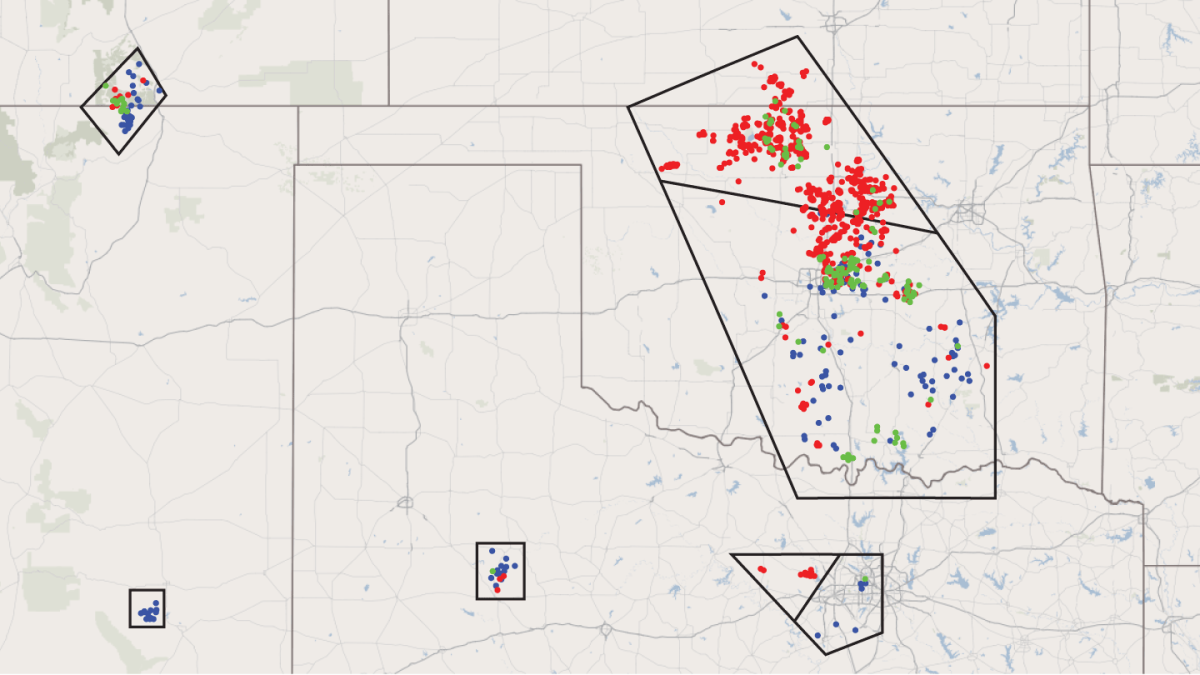Man-made earthquakes increasing in central and eastern U.S., study finds
- Share via
For the first time, the U.S. Geological Survey has unveiled a map of earthquakes thought to be triggered by human activity in the eastern and central United States.
Oklahoma is by far the worst-hit state recently, according to the USGS study released Thursday. The state last year had more earthquakes magnitude 3 or higher than California, part of a huge increase recorded in recent years.
Seismic activity in Texas near the Dallas-Fort Worth area has also increased substantially recently. Kansas, Colorado, New Mexico and Ohio have all experienced more frequent quakes in the last year.
FULL COVERAGE: California earthquakes
All of the areas highlighted on the map “are located near deep fluid injection wells or other industrial activities capable of inducing earthquakes,” the study said.
Mark Petersen, chief of the USGS' National Seismic Hazard Project, said the pattern of increased quakes is troubling.
“These earthquakes are occurring at a higher rate than ever before, and pose a much greater risk and threat to people living nearby,” Petersen said.
The release of the map comes as officials are coming to terms with the idea that wastewater disposal following oil and gas extraction is causing more earthquakes. Hydraulic fracturing, or fracking, involves shooting a high-pressure mix of water, sand and chemicals deep underground to extract oil and natural gas. The resulting wastewater is often forced underground as well, but can trigger earthquakes on faults that haven’t moved in a very long time.







The Oklahoma Geological Survey said Tuesday that the sharp rise in quakes in that state is “very unlikely to represent a naturally occurring process,” since they are occurring over the same area that saw a huge jump in wastewater disposal in the last several years.
The seismicity rate in 2013 was 70 times greater than the background seismicity rate observed in Oklahoma prior to 2008, state officials said.
Human-induced earthquakes have troubled scientists because they pose a risk to public safety — and because they have become larger. A magnitude 5.6 earthquake believed to have been caused by wastewater injection hit near Prague, Okla., in 2011, injuring two people and destroying 14 homes. That same year, a 5.3 earthquake struck a remote part of Colorado, near the town of Trinidad close to the New Mexico border, which the USGS said was also triggered by wastewater injection.
History suggests that even larger earthquakes could be in store.
“We know, for example, in Oklahoma that there was an earthquake of about magnitude 7 about 1,300 years ago,” said USGS geophysicist William Ellsworth. “We have to be guided with what we have seen in the past.”
The idea that injecting water deep into the ground can trigger earthquakes has been talked about for decades.
In the 1960s, many scientists concluded that injection of chemical-waste fluid in the Denver Basin triggered seismic activity, according to a study at the time in the journal Science.

16
9
OHIO
17
8
11
Kansas
COLORADO
2
10
1
OKLAHOMA
14
NEW MEXICO
3
ARKANSAS
5
4
6
ALABAMA
7
13
15
TEXAS
LOUISIANA
12
FLORIDA










Before 1976, earthquakes were rare in the desert town of Gazli in the former Soviet republic of Uzbekistan. Like Oklahoma, this Soviet region was far away from the boundaries of the giant tectonic plates whose crashes create the huge quakes well known in places such as California.
Then two big earthquakes hit the Gazli area that year, and a magnitude 7 quake struck in 1984, killing one person and injuring more than 100. Scientists writing in the Bulletin of the Seismological Society of America at the time suggested that the quake could have been induced by human activity at the gas field.
Now that the USGS maps have been released, one big question is what to do about the man-made quakes.
USGS geophysicists Art McGarr and Andy Michael called for better monitoring of regions with increased seismic activity. Some areas rely on relatively crude seismic sensors that can’t precisely identify the location of quakes that are smaller than a magnitude 3. But that knowledge could help scientists identify areas where seismic pressure is building up.
It would also aid them in determining the size of unmapped faults in these areas.
“It’s a bit frustrating when we don’t have really good earthquake locations,” Michael said.
And better data could help scientists manage the quake risk. Not all wastewater injection causes earthquakes, Ellsworth said, and regulators in some areas may opt to restrict wastewater injection in places where the risk is high.
SPECIAL REPORT: California earthquake safety
Officials in Kansas have already ordered a reduction in wastewater injections in certain areas, and authorities are observing whether it will be followed by a reduction in quakes.
“We think society can manage the hazard,” Ellsworth said. “We don’t have to stop production of oil and gas, but we think we can do so in a way that will minimize the earthquake hazard.”
For instance, the risk could be reduced by placing new wastewater injection sites further away from cities or critical facilities where large earthquakes are a big worry, Ellsworth and McGarr wrote in an essay published in the journal Science in February.
“The general public is the most important stakeholder because they may be exposed to potential injury and damage,” the pair and their colleagues wrote. “If an induced earthquake sequence results in damage, then blame can be assigned with legal implications for liability. The question of whether an earthquake sequence was induced or natural is of more than academic interest.”
Follow me on Twitter: @ronlin
ALSO:
The Big One could trigger series of large earthquakes, study finds
Earthquake fault heightens California tsunami threat, experts say
Nearly half of Americans threatened by earthquakes, study finds







